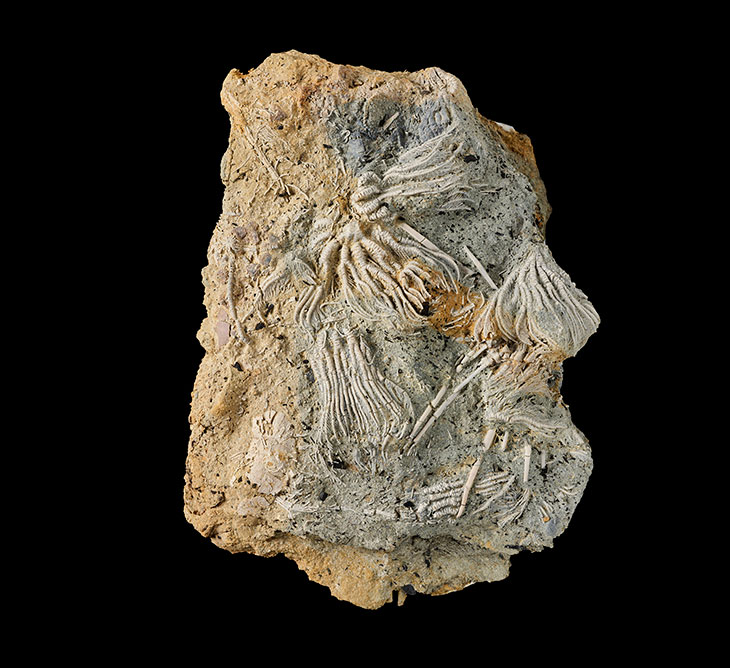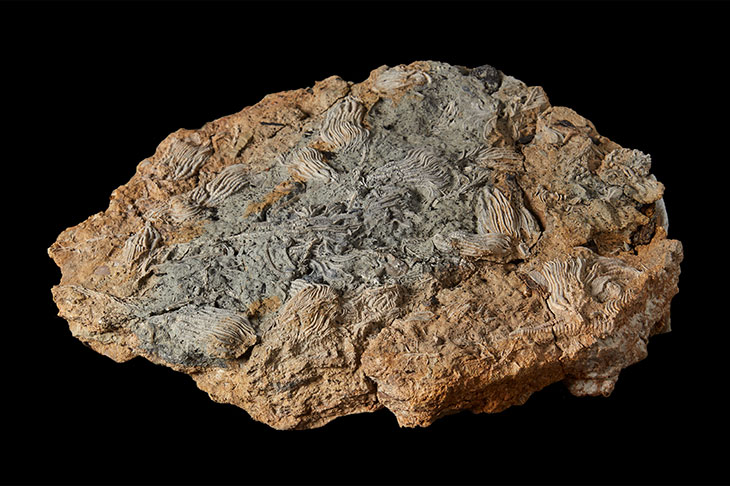During lockdown Sally and Neville Hollingsworth, two amateur palaeontologists, sat down with Google Earth and a bunch of geological maps and uncovered one of the UK’s most significant hauls of Jurassic fossils. For around 167 million years these creatures had been locked away in the darkness underneath layers of rock and mud in a quarry in a sleepy corner of the Cotswolds. Now, brought up into the light, freshly washed, they gleam like marble sculptures of alien lifeforms. Long segmented limbs, feathery tentacles, tube-like appendages: the level of preservation is stunning, as though the creatures had sat for their portraits just hours earlier. ‘It’s the kind of thing you dream about,’ Jeffrey Thompson, a research scientist from the Natural History Museum (NHM) in London, tells me. ‘I’ve not come across another locality like it.’
Living in the Cotswolds, you are surrounded by evidence that our world is not the only world to have existed. Crossing the local common on his way to school, my husband, who grew up in the area, used to find embedded in the ground the fossils of ancient sea creatures – evidence that the grassy hillside had once been at the bottom of a warm shallow ocean. The climate then would have been subtropical. On dry land dinosaurs thundered between conifer plants.
Much of what we know about this lost world comes from the work of Victorian fossilists who took advantage of a 19th-century boom in quarrying and railway building to collect their specimens. This means that the discovery of a huge new wodge of Jurassic sea floor is likely to radically update our knowledge. Finding any fossil is something of a miracle – scientists estimate that perhaps less than one tenth of one per cent of all species that have ever lived become fossils – but here the quality of preservation, the diversity of species and the sheer number of fossils at the site are all unprecedented. Typically, Thompson considers it an exceptionally good day’s fossil hunting if he comes away with one complete, articulated sea lily. At the quarry he’d pick up a slab and find dozens of specimens.

Sample of preserved echinoderms found in a quarry in the Cotswolds. Photo: © Trustees of the Natural History Museum
‘Imagine a meadow of sea grass,’ Thompson says, ‘but instead of it being grass, picture all of these stalked crinoids [sea lilies].’ Sea lilies – despite the name, animals, not plants – rooted themselves to the sea bed, feathery arms swaying in the current as they searched for food. (If you’re in London you can also find some striking, though less well-defined examples in the purplish limestone slabs used as flooring in the Royal Festival Hall.) The sea lilies would have been surrounded by a rich and diverse ecosystem including sea urchins, feather stars, brittle stars and sea cucumbers – all of which have been found at the site.
Then, disaster struck. We don’t know exactly what happened but something, perhaps an earthquake, sent tonnes of mud and sand on to the sea floor. ‘They tried to protect themselves, adopting the stress position of pulling their arms in,’ Tim Ewen, senior curator at the NHM, said in a BBC interview. ‘But it was all in vain; you can see where their arms got snagged open, right up to the crown. They were pushed into the sediment and buried alive.’ It’s the sort of event that makes fossilisation more likely because the bodies are preserved intact rather than scavenged.
After only three days of digging NHM scientists were already able to announce the discovery of three new species – a type of feather star, a brittle star and a sea cucumber. Just as important, however, is the chance to explore a beautifully preserved Jurassic environment in its entirety – something which will feed into global biodiversity studies – while an abundance of creatures from the same species gives scientists the opportunity to study entire life cycles from infancy to adulthood.

Sample of preserved echinoderms found in a quarry in the Cotswolds. Photo: © Trustees of the Natural History Museum
For scientists trying to understand the processes of evolution, this new material will prove invaluable. If we want to figure out why the world we live in is the way that it is, then understanding how things got assembled through deep time is an important part of that. After all, if you only look at organisms that are alive today, you’re missing out on billions of years of the story. ‘And all evolutionary science is really interconnected,’ Thompson tells me. To take a current example, some of the statistical models that have been used to try to understand the evolution of Covid are the exact same statistical models that scientists use to try and understand how biodiversity fluctuated through deep time. ‘We might learn things about these statistical models that we’ve been applying to data in deep time that could potentially help us to understand things like viral evolution [in 2021].’
Having completed the initial three-day dig, the Hollingsworths and the NHM scientists now plan to return to the quarry. There are more discoveries to make. And, placed in their global, historical context, these discoveries may affect not just our knowledge of the past and present but of the future – most pressingly the future of our climate crisis. ‘The climate has always changed throughout deep time, and we can learn by studying it,’ Thompson says. ‘We can look at ancient biodiversity loss, mass extinction events, and that allows us to determine what could potentially happen as our own climate changes. The past gives us lessons about the future.’












![Masterpiece [Re]discovery 2022. Photo: Ben Fisher Photography, courtesy of Masterpiece London](http://zephr.apollo-magazine.com/wp-content/uploads/2022/07/MPL2022_4263.jpg)
‘Like landscape, his objects seem to breathe’ – Gordon Baldwin (1932–2025)